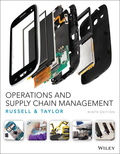
Operations and Supply Chain Management 9th edition
9th Edition
ISBN: 9781119320975
Author: Roberta S. Russell, Bernard W. Taylor III
Publisher: WILEY
expand_more
expand_more
format_list_bulleted
Question
Chapter 1.S, Problem 25P
Summary Introduction
To draw: The maximum amount that should be paid to the analyst
Introduction: Decision analysis can be interpreted as the most common technique to make a decision in the situation when there is uncertainty. It uses quantitative measures to analyze the decision that is also used in operation of the firms.
Expert Solution & Answer
Want to see the full answer?
Check out a sample textbook solution
Students have asked these similar questions
How much does self-awareness influence the Interpersonal Trust Scale's results?
Which of the following statements about organization's strategy is FALSE?
OA. They are formulated after the organization's mission is determined.
OB. They reflect an organization's purpose.
OC. An organization's strategy exploits opportunities and threats.
OD. They help determine how an organization expects to achieve its miss
OE. Each functional area of the organization will have a strategy.
The ability of an organization to match changes in a marketplace where design
volumes fluctuate substantially is:
OA. competing on productivity.
OB. mass production.
OC. time-based competition.
OD. competing on differentiation.
O E. competing on response.
Porter's Five Forces Model is used to evaluate competition based on which 5 asp
A. immediate rivals, potential entrants, customers, suppliers, and substitute
B. potential entrants, customers, suppliers, legal regulations, and cost
please answer
Chapter 1 Solutions
Operations and Supply Chain Management 9th edition
Ch. 1.S - Prob. 1PCh. 1.S - Prob. 2PCh. 1.S - Prob. 3PCh. 1.S - Prob. 4PCh. 1.S - Prob. 5PCh. 1.S - In Problem S1-5 assume that Nicole, with the help...Ch. 1.S - Prob. 7PCh. 1.S - Prob. 8PCh. 1.S - Telecomp, a computer manufacturer with a global...Ch. 1.S - Prob. 10P
Ch. 1.S - Prob. 11PCh. 1.S - Prob. 12PCh. 1.S - Prob. 13PCh. 1.S - Prob. 14PCh. 1.S - Prob. 15PCh. 1.S - Prob. 16PCh. 1.S - Prob. 17PCh. 1.S - Prob. 18PCh. 1.S - In Problem S1-18, assume the Weight Club is able...Ch. 1.S - Prob. 20PCh. 1.S - Prob. 21PCh. 1.S - Prob. 22PCh. 1.S - Prob. 23PCh. 1.S - Prob. 24PCh. 1.S - Prob. 25PCh. 1.S - Prob. 26PCh. 1.S - Prob. 27PCh. 1.S - Prob. 28PCh. 1.S - Prob. 29PCh. 1.S - Prob. 30PCh. 1.S - Prob. 31PCh. 1.S - Prob. 33PCh. 1.S - Prob. 34PCh. 1.S - Alex Mason has a wide-curving, uphill driveway...Ch. 1.S - Prob. 36PCh. 1.S - Prob. 39PCh. 1.S - Prob. 40PCh. 1.S - State University has three healthcare plans for...Ch. 1.S - The Orchard Wine Company purchases grapes from one...Ch. 1.S - Prob. 43PCh. 1.S - Prob. 1.1CPCh. 1.S - Prob. 2.1CPCh. 1.S - Evaluating Projects at Nexcom Systems Nexcom...Ch. 1 - Feeding America Each year, the Feeding America...Ch. 1 - Feeding America Each year, the Feeding America...Ch. 1 - Feeding America Each year, the Feeding America...Ch. 1 - Feeding America Each year, the Feeding America...Ch. 1 - Prob. 1QCh. 1 - What constitutes operations at (a) a bank, (b) a...Ch. 1 - Prob. 3QCh. 1 - Prob. 4QCh. 1 - Prob. 5QCh. 1 - Prob. 17QCh. 1 - What is the difference between an order winner and...Ch. 1 - Prob. 21QCh. 1 - Prob. 22QCh. 1 - Prob. 23QCh. 1 - Prob. 24QCh. 1 - Prob. 1PCh. 1 - Prob. 2PCh. 1 - Prob. 3PCh. 1 - Prob. 4PCh. 1 - Prob. 5PCh. 1 - Omar Industries maintains production facilities in...Ch. 1 - Rushing yardage for three Heisman Trophy...Ch. 1 - Carpet City recorded the following data on carpet...Ch. 1 - Prob. 9PCh. 1 - Prob. 10PCh. 1 - Prob. 11PCh. 1 - Prob. 12PCh. 1 - Prob. 13PCh. 1 - Prob. 14PCh. 1 - Prob. 15PCh. 1 - Prob. 1.1CPCh. 1 - Prob. 1.2CPCh. 1 - Prob. 1.3CPCh. 1 - Prob. 1.4CPCh. 1 - Prob. 1.5CPCh. 1 - Prob. 2.1CPCh. 1 - Prob. 2.2CP
Knowledge Booster
Similar questions
- In the 2016, "ATB: digital disruption in the parking meter industry" perform a finanacial analysis and make a chart similar to this one 2013 2014 Current Ratio 1.88 1.41 Quick Ratio 0.49 0.29 Debt to Equity 0.95 1.92 Return on Assets 5.47% 2.76% Net Profit Margin 2.71% 1.89%arrow_forwardPerform a VRIO Analysis on the 2016 "ATB: Digital disruption in the parking meter industry" and make a chart similar to this one V R I O Topic Y Y Y Y Relations with John Deere and Paccar Y N N Y Customer Relations Y Y Y Y Acquisition and Integration Process Y Y Y N Cervus Leadership University Y Y N Y Proactive Management Y Y N Y Financial Position Y N N N Scale of Organizationarrow_forwardHow do incorporated stress management techniques impact future emotional strength and wellness? What are the lesson learned from incorporating stress management techniques in the past that reflects developing emotional resilience?arrow_forward
arrow_back_ios
SEE MORE QUESTIONS
arrow_forward_ios
Recommended textbooks for you
 Purchasing and Supply Chain ManagementOperations ManagementISBN:9781285869681Author:Robert M. Monczka, Robert B. Handfield, Larry C. Giunipero, James L. PattersonPublisher:Cengage Learning
Purchasing and Supply Chain ManagementOperations ManagementISBN:9781285869681Author:Robert M. Monczka, Robert B. Handfield, Larry C. Giunipero, James L. PattersonPublisher:Cengage Learning Practical Management ScienceOperations ManagementISBN:9781337406659Author:WINSTON, Wayne L.Publisher:Cengage,
Practical Management ScienceOperations ManagementISBN:9781337406659Author:WINSTON, Wayne L.Publisher:Cengage, Management, Loose-Leaf VersionManagementISBN:9781305969308Author:Richard L. DaftPublisher:South-Western College Pub
Management, Loose-Leaf VersionManagementISBN:9781305969308Author:Richard L. DaftPublisher:South-Western College Pub Contemporary MarketingMarketingISBN:9780357033777Author:Louis E. Boone, David L. KurtzPublisher:Cengage Learning
Contemporary MarketingMarketingISBN:9780357033777Author:Louis E. Boone, David L. KurtzPublisher:Cengage Learning

Purchasing and Supply Chain Management
Operations Management
ISBN:9781285869681
Author:Robert M. Monczka, Robert B. Handfield, Larry C. Giunipero, James L. Patterson
Publisher:Cengage Learning

Practical Management Science
Operations Management
ISBN:9781337406659
Author:WINSTON, Wayne L.
Publisher:Cengage,


Management, Loose-Leaf Version
Management
ISBN:9781305969308
Author:Richard L. Daft
Publisher:South-Western College Pub

Contemporary Marketing
Marketing
ISBN:9780357033777
Author:Louis E. Boone, David L. Kurtz
Publisher:Cengage Learning